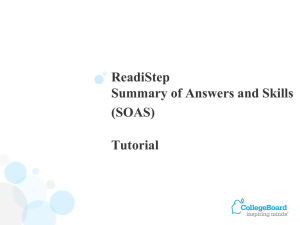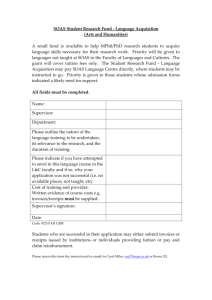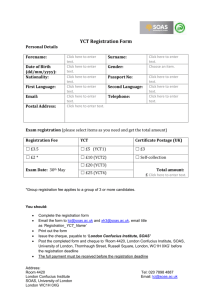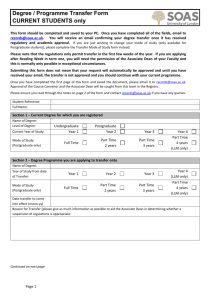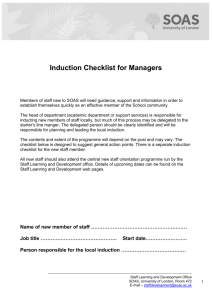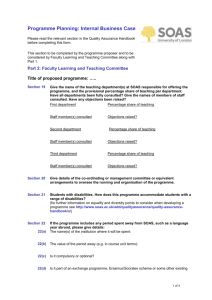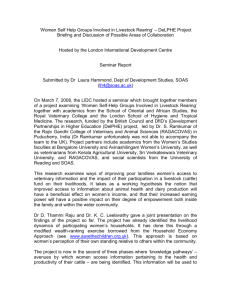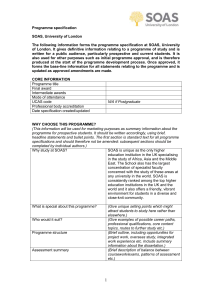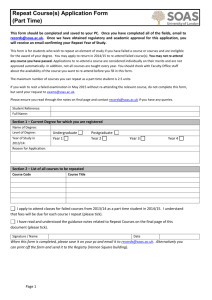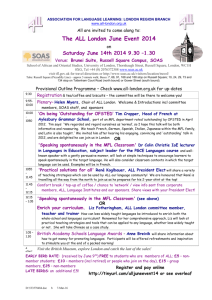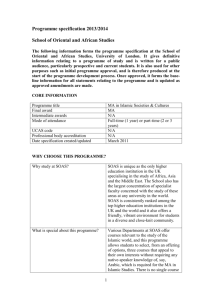How does it all add up? - The College Board
advertisement
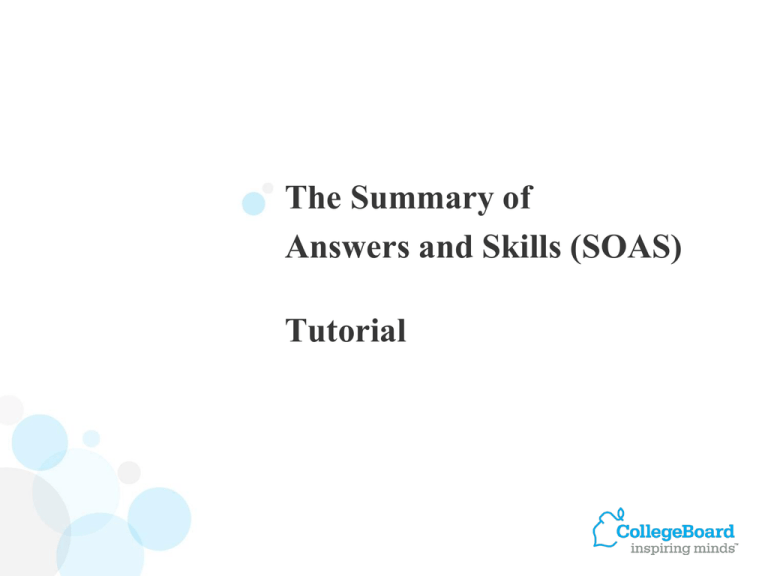
The Summary of Answers and Skills (SOAS) Tutorial SOAS Introduction Audience • Administrators • Department heads • Curriculum specialists • Teachers • Other staff interested in students’ college preparatory skills Note: the more inclusive the testing within each grade, the more meaningful and applicable the results. Logging In Repeat Users www.collegeboard.com/results Logging In New Users If it’s your first time, you’ll need your school’s SOAS access code Supporting Materials SOAS Resources Your Reports Report Orientation Table of Contents Page(s) • Title Page • Performance Overview 1 • Skills Analysis 2, 6-7, 11 • Question Analysis 3-4, 8-9, 12-13 • Comparable Group Analysis 5, 10, 14 Performance Overview Page 1 • Number of students in report • Mean scores and • score distribution • College Readiness Benchmarks Skills Analysis Pages: 2, 6-7, 11 • Skills • Triangles show a comparison to the state and nation • Each test question is linked to a skill Activity B Review Skills Analysis Instructions • Work within your own school group/academic area, using your school’s SOAS report. • Identify the skill that your students had the lowest performance on. • Using the Test Question and Answer Explanations, look at each question aligned to that skill. • Things to look for: Skills furthest below the state/national average. Skills that are furthest to the left (i.e. those that are the weakest for the group). Skills that came to your attention after review of Question Analysis. Activity B Review Skills Analysis Questions for Consideration Within your group, please answer the following: 1. Is there any pattern in the skills you identified as problematic? 2. Are there actions or strategies that might help address where students are struggling with certain skills? 3. What skills are relatively strong for your students? Why? Question Analysis Pages: 3-4, 8-9, 12-13 • Student responses and answer patterns • Comparisons to the state and nation Question Analysis Tips: Look for questions your Students answered incorrectly that the students in the state and nation answered correctly Look for commonly Wrong answers Activity C Review Question Analysis Instructions • Work within your own school group/academic area, using your school’s SOAS report. • Refer to the Test Questions and Answer Explanations to make note of problem questions and how they might be addressed. • Things to look for: Easier questions (difficulty level 1-3) where fewer than 2/3 of the students answered correctly. A larger proportion of your students answered incorrectly or omitted an answer in comparison to the state/nation. Commonly wrong answers. Review any questions that generated interest when you reviewed the test questions in Activity A. Activity C Review Question Analysis Questions for Consideration Within your group, please answer the following: 1. Are there any patterns in the questions you identified as problematic? 2. Are there actions or strategies that might help students master the skills assessed by these questions? 3. What are the key highlights from your discussion that your group would like to share? Please include both strengths and areas of concern. Comparable Group Analysis Pages: 5, 10, 14 SOAS Comparable Group What is a comparable group? • A useful statistical model • A statistically created group (virtual group) • Mirrors your group’s performance profile • This creates an expected performance indicator for your group on each question • Provides more “actionable” feedback than state or national averages on questions/skills Comparable Group Analysis Pages: 5, 10, 14 Darker blue = significantly below the comparable group Lighter blue = significantly above the comparable group Activity D Comparable Group Analysis Instructions 1. Work within your own school group/academic area, using your school’s SOAS report. 2. Using the Test Question and Answer Explanations, look at each question. 3. Things to look for: Questions that fall into the dark blue area, where your students performed below expectation. Questions that fall into the light blue area, where your students performed higher than expectation. Activity D Comparable Group Analysis Questions for Consideration Within your group, please answer the following questions: 1. Is there a pattern in the skills aligned with the test questions on which your students performed below expectation? 2. Is there a pattern in the skills aligned with the test questions on which your students performed above expectation? 3. What new information, if any, have you learned from this analysis? Has this changed your thoughts about anything that your group previously discussed? Why or why not? Resources Resources Test Questions and Answer Explanations How does it all add up? Critical Reading example Step 1 of 4: Use reports to find a question you’d like to analyze. Critical Reading Question 5 How does it all add up? Critical Reading example Step 2 of 4: Identify the skill measured by this question. Critical Reading Question 5 How does it all add up? Critical Reading example Step 3 of 4: Review the question, answer, and answer explanation. Critical Reading Question 5 How does it all add up? Critical Reading example Reading: Question 5 Venomous fish are often ------- in appearance; their intense colors may serve to warn enemies away. (A) flamboyant (B) clumsy (C) tranquil (D) elephantine (E) diminutive Question 5 measures the skill: Determining the Meaning of Words 26 How does it all add up? Critical Reading example Step 4 of 4: Making connections to state and Common Core Standards. Critical Reading Question 5 Determining the Meaning of Words How does it all add up? Critical Reading example Step 4 of 4: Making connections to state and Common Core Standards. Critical Reading Question 5 Determining the Meaning of Words How does it all add up? Critical Reading example The skill Determining the Meaning of Words aligns to the State Standard and the Common Core State Standard. Determining the Meaning of Words 29 Insert State Standard Insert Common Core State Standard How does it all add up? Math example Question 25 (Multiple Choice) Level of Difficulty = (E) Skill = Data, Statistics, and Probability According to the pictogram above, if China had 100 million Internet users in 2005, approximately how many million did India have? A) 54 B) 48 C) 37 D) 25 E) 18 How does it all add up? Math example Step 1 of 4: Use reports to find a question you’d like to analyze. Math Question 25 How does it all add up? Math example Step 2 of 4: Identify the skill measured by this question. Math Question 25 How does it all add up? Math example Step 3 of 4: Review the question, answer, and answer explanation. Math Question 25 How does it all add up? Math: Question 5 34 Question 5 measures the skill: Data, Statistics, and Probability How does it all add up? Math example Step 4 of 4: Making connections to state and Common Core Standards. Math Question 25 Data, Statistics, and Probability How does it all add up? Math example Step 4 of 4: Making connections to state and Common Core Standards. Math Question 25 Data, Statistics, and Probability How does it all add up? Math example The skill Data, Statistics, and Probability aligns to State Standards and the Common Core Standards. Data, Statistics, and Data, Probability Statistics, and Probability Insert State Standard Insert Common Core Standard 37 Using Your SOAS Data Identify the skills associated with the questions students answered incorrectly. Make inferences about what led to errors. Identify where in the curriculum the skills are (or are not) taught. Work with departments and classrooms to review common concerns. What recommendations can you make to your school for increased student success? Using Assessments for School Improvement • Identify skills to help guide instruction and curriculum planning. • Connect more students with challenging high school courses and then college. • Identify students who would likely benefit from the rigor of an Advanced Placement course in your school. • Help close the achievement gap in your school community. Looking Ahead: 2012 PSAT/NMSQT Wednesday, October 17th Saturday, October 20th
